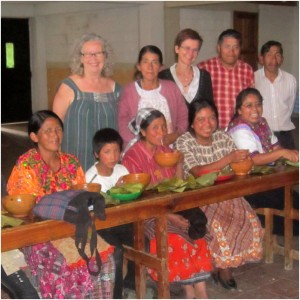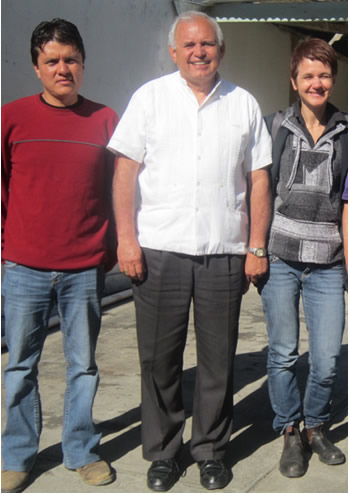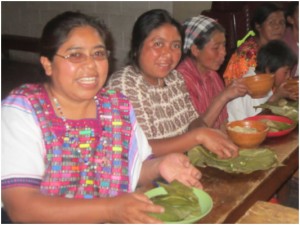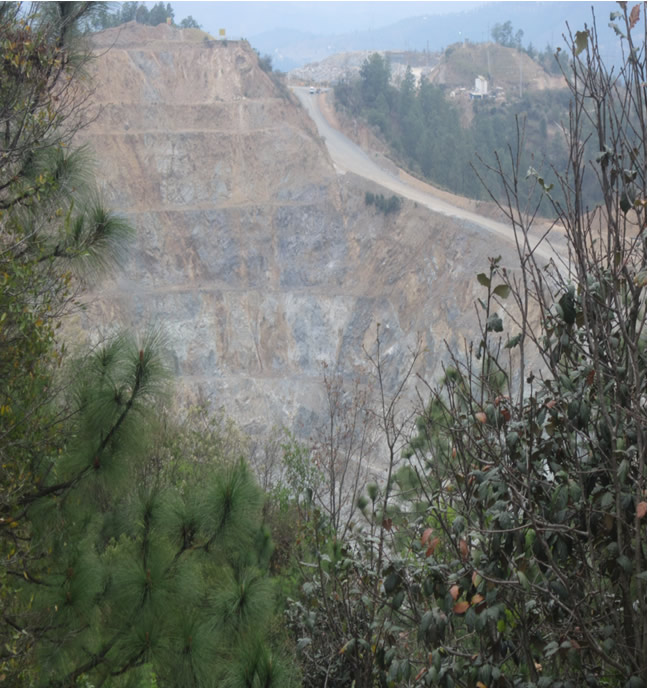Whose Development? Reflections on my visit to the Marlin Mine and meeting with community members
By Rachel Warden
“They said the mine would bring development, but they didn’t mean development for us, unless they meant the development of sickness, environmental damage, of social conflict and threats,”
– community member from San Miguel Ixtahuacan
We were talking with the Pastoral Committee for Defense of Mother Earth of the Catholic Parish in San Miguel Ixtahuacan, which includes people from the 62 Indigenous communities that surround the Marlin Mine in the municipality of San Miguel Ixtahuacan, in San Marcos, Guatemala. It was a discussion about opposing views of development. These Indigenous people are living with the impact of the mine and they do not share the company’s view of development, and do not believe its promises of economic gain and improved infrastructure.

With members of the Pastoral Committee for Defense of Mother Earth of the Catholic Parish in San Miguel Ixtahuacan
“We don’t have words to describe all the impacts. And what about the impacts and risks in the future that we are not seeing now?” asked one woman. But they went on to describe the indescribable – cancer, skin disease, water contamination, the poisoning of livestock and crops. And the social impacts – increased alcoholism, suicide and drug- use, social conflict and violence. “There is conflict within families, communities. People insult me in the streets and even in church. It is no longer safe to walk the streets at night,” one young man said. Many of these impacts have been documented and denounced, nationally and internationally, but the mine persists. In fact, in May 2010 the InterAmerican Human Rights Commission (IAHRC) recommended to the Guatemalan government that it impose a moratorium on the operation of the mine because of the lack of consultation with Indigenous communities, and continuing concerns about water contamination. In December last year in what is feared to be a weakening of the court’s position on these issues, the IAHRC withdrew its recommendation for a moratorium.
The parish of San Miguel, along with the Diocese of San Marcos, have supported these communities and continue to denounce the mine’s impact, at great risk to themselves. Bishop Ramazzini , the Diocesan Bishop and a strong, vocal and consistent opponent of the mine, recently issued a strong statement detailing its environmental and social impacts.
At the meeting a representative from the parish radio of San Miguel said that when they began to denounce the mine on the radio, he began receiving threats. “As well as the constant threats and insults to me and my family, they accuse me of not preaching the word of God. They say we should be speaking about God, not the environment. They even insult me in church, “he explained. “ I feel like I am living in a den of wolves.”
Sister Maudilia, a member of the Pastoral Commission in Defense of Mother Earth, said that before the mine’s arrival there may not have been as much money and infrastructure, but there was harmony and the communities lived according to their Mayan “cosmovision” or world view. “Then the mine came along and offered us development, but not for the well -being of everyone.” She went on to say that the money and infrastructure projects have been used to blind people. “What bothers me most is how the company has exploited the trust and culture of the Mayan people,” she said. “And they know exactly what they are doing.”
We were able to record a message from Sister Maudilia to members of the Maritime Conference of the United Church of Canada who at the end of May will be considering a resolution calling for the divestment of United Church pension funds from Goldcorp. In this message Sister Maudilia speaks forcefully about the mine’s grave impact on communities, and on the need to divest. “I have been told by ethical investment groups that they do not invest in arms because they kill people. But my question is what is the difference between killing people with guns or killing people more slowly with mining?” .
Before the meeting with the Parish commission, I visited the area around the mine with Kathryn Anderson and Wilf Bean from the Maritime Conference of the United Church. We were accompanied by KAIROS partner CEIBA. Kathryn and Wilf have visited the area on a number of occasions, but this was my first time. Over the past 5 years, I have seen videos and photos of the mine, read numerous reports from civil society and the company, and responded to urgent action requests, but none of this prepared me for what I saw when I got close to the mine. Now I understood what community members meant when they claimed they had no words to describe the mine’s impact. It is truly difficult to find words to describe its immensity.
There are numerous reports describing the magnitude of the open pit, the size of the tailing pond, the amount of water required, the amount of cyanide used, even the number of football fields that could fit inside the mine, but somehow all these facts and figures make it seem too logical, too manageable. Up close there is something extraterrestrial about it. It’s like some huge alien has gauged out an entire mountain and left in its wake an immense pool of sinister iridescent green liquid.
According to a resolution that will be tabled at the Goldcorp AGM on April 26 in Timmins, the company has budgeted $1 million for reclamation after the mine’s closure. In contrast, the resolution being put forward by a number of concerned shareholders calls on the company to ensure at least $49million for reparation – the amount recommended by an independent panel of geo-engineers hired by the Unitarian Universalist Service Committee. After seeing the mine, and hearing first-hand about its impact, even $49million seems insufficient. As well as the long-term environmental impacts, there are the lasting social impacts. “What amount of money will repair the conflict and hate that exists within communities now,” asked Maudilia. I hope the shareholders are able to understand, even partially, the lasting environmental and social impacts of the mine, and that they vote in favour of the resolution.

Bishop Ramazzini from the Diocese of San Marcos, Eric Hernandez from CEIBA and Rachel Warden from KAIROS
Later that evening we met with Bishop Ramazzini from the Diocese of San Marcos. He welcomed us into his home and agreed to record a message for the Maritime Conference of the UCC. In his message he calls for a moratorium on the mine and asks the UCC to divest from Goldcorp. “What is the point of working for incremental improvements in the company’s behaviour and trying to mitigate the impacts of the mine when we already know that impacts to the environment and the social fabric of the communities are so grave,” he asks.
Ramazzini was a key advocate for the Ecumenical Conference on Mining that KAIROS helped coordinate last year, participating in its planning and organization. When we met, he encouraged us to reactivate the network of 150 people and 50 international partners who participated “It is time to revive the statement and commitment that came out of that conference,” he said.






